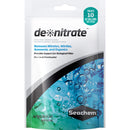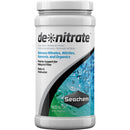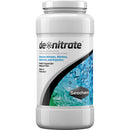





de❊nitrate™ is an economical, natural, porous material with a pore distribution and geometry that promotes both aerobic nitrification within the first few millimeters of depth and anaerobic denitrification at the core. The material has a high surface area and supports a high density of bacteria. Although de❊nitrate™ has capacity to trap nitrate, this, as with other nitrate retaining materials, such as certain zeolites and synthetic resins, is quite limited and the primary mechanism of nitrate removal is anaerobic.
“Live” rocks or reef rocks remove nitrate by anaerobic denitrification. de❊nitrate™ removes nitrate by the same process. Efficiency is magnified several folds by forcing the water to filter through the porous de❊nitrate™. As with reef rock, anaerobic conditions are achieved by the porosity and the depletion of oxygen by the aerobic process at the surface. Excessive flow rates should, therefore, be avoided, as they may impede development of an adequate anaerobic environment to support denitrifying bacteria.
de❊nitrate™ is also an excellent media for aerobic nitrification and it makes an ideal biological filter in drip trays, canister filters, sumps, or even box filters. At high flow rates (greater than 100 US gallons per hour), it will function solely as an aerobic filter. At slow flow rates (less than 50 US gallons per hour), it will function as both an aerobic filter and an anaerobic denitrifying filter.
Sizes: 100 mL, 250 mL, 500 mL
Directions
For best results, de❊nitrate™ should be placed to assure the flow of water through it, such as in a canister filter, chemical filtration module, or box filter. Flow rate should not exceed 200 L (50 US gallons) per hour. If higher flow rates are unavoidable, use Matrix™ or Pond Matrix™. It is best to rinse off dust before use. Once de❊nitrate™ has been in use for several days, nitrate concentrations should start to fall and level off gradually at a concentration of about 4–5 mg/L as nitrate. As long as nitrate concentrations remain under control, the product is not exhausted. Each 500 mL of de❊nitrate™ treats about 100–200 L (25–50 US gallons), depending on initial nitrate concentration and the current biological load. Enough should be used to remove nitrate at a rate at least as fast as the rate of formation. If very high nitrates are initially present, they should be brought down to less than 20 mg/L with water changes.
FAQ
How much nitrate will de❊nitrate™ remove?
A: It is recommended that if nitrate levels are very high that they be brought down to at least 20 ppm through water changes before using de❊nitrate. At that point de❊nitrate™ will bring the nitrate levels down to 4 – 5 ppm after several days of use. Since de❊nitrate, Matrix,and Pond Matrix are all biological support media, they do not actually ever exhaust, but they can grown less efficient with use by pore clogging. Prefiltering the water before it passes through these products will extend its useful life.
What allows de❊nitrate™ to function anaerobically at flow rates less than 50 GPH?
A: It is the porosity of this material that allows it to function at this rate of water flow. As water passes through this media, any oxygen is used by the aerobic bacteria that lives on the outer crust of this media. As water enters the inner crust of this media, it will come in contact with the bacteria groups that live in oxygen deficient conditions of the inner portions of this media that naturally consume and dispose of nitrate.
The directions state that the flow rate through de❊nitrate™ should not be more than 50 gallons per hour, but most filters on the market flow much faster than that. How do I achieve such a slow flow rate?
A: The best way to accomplish this is with the use of a flow through (aka "dummy canister"). Other alternatives include water restriction to a regular canister, placement in a sump, or a box filter with a restricted intake.
Should I use Matrix™ or de❊nitrate? It seems like they both remove nitrate.
A: Matrix™ is best when you want a multi-purpose filter media to house both aerobic and anaerobic bacteria or when you cannot set up a filter with a flow rate of less than 50 gallons per hour. It will remove nitrate, but not as much nitrate as de❊nitrate™ can. de❊nitrate™ is better when you specifically want to remove nitrate and you already have plenty of biomedia for aerobic bacteria.
How often do I need to rinse or replace de❊nitrate?
A: de❊nitrate™ is a biomedia, meaning it does not exhaust over time, so you should never need to replace it. That said it is possible for de❊nitrate™ to become clogged up with detritus and slime, so we recommend prefiltering the water using a sponge or filter floss to extend the useful life of the product.
Payment & Security
Your payment information is processed securely. We do not store credit card details nor have access to your credit card information.
